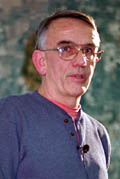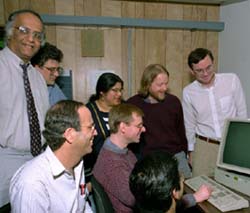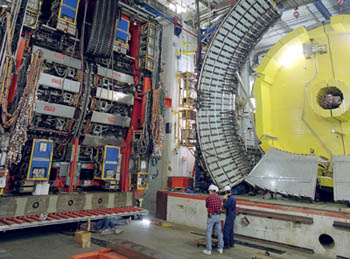 |
|
Twenty years at the energy frontier by Paul Grannis
The Tevatron began operations in late1983 when the E715 experiment initiated the use of the world's highest-energy beams. Since then more than forty fixed-target experiments have used Tevatron beams of protons, pions, muons, photons, hyperons and neutrinos to expand our knowledge of particles and forces. These experiments were bewilderingly—to the non-initiated—named by experiment numbers. Somewhere around E800, more descriptive names of experiments became common. Through several fixed-target experiments we have learned much about particles containing charm and bottom quarks, and have greatly improved our understanding of the distributions of quarks, antiquarks and gluons within the proton and neutron. It took years of data taking and analysis to explore the small difference of particle interactions between matter and antimatter, known as CP violation. Investigating K meson decays, the KTeV collaboration helped establish that CP violation arises through two different mechanisms. DONuT made the first direct sighting of the elusive tau neutrino in 2000, producing headlines around the world. In 2001, the NuTEV experiment caused excitement when its measurement of the mixing angle related to the breakdown of the electroweak symmetry complemented—but somewhat disagreed with—results from LEP, SLC and Tevatron collider experiments. The Tevatron collider began operation in late 1985 with a handful of proton-antiproton collisions seen in the partially completed Collider Detector at Fermilab. The CDF experiment started in earnest in 1987, while the more junior DZero collaboration, which started from scratch in 1983, began operating its detector in 1992. It proved to be important for the field that there were two large general purpose experiments. We've learned much from the techniques invented by both collaborations, and sometimes the two groups have combined scientific results to make more progress than possible with one experiment alone. Although CDF and DZero share their main goals, the true modus vivendum has been of sibling rivalry. This competition often brings out the best in both collaborations, as they try to wring every ounce of significance from the data. My view of the collider's high points are of course colored by the rose tinted glasses worn by those of us who have labored at DZero and CDF, where the men are good looking, the women are strong, and the physics is all above average. Indeed, it is the people of the collaborations and the Accelerator Division—now Beams Division—who have made the Tevatron the success that it has been. The real hero is the Tevatron itself, whose collision energy of nearly 2 TeV and luminosity more than 10 times its design value made the discoveries possible.
DZero and CDF have achieved results exceeding the hopes of almost everyone. An obvious highlight was the discovery of the top quark in 1995, and the measurement of its mass and its production rate. Assuming the Standard Model of particles and interactions, experiments at LEP and SLC had given an indication of its mass. Nevertheless, the extraordinarily large mass, almost 40 times the mass of the next heaviest bottom quark, was unexpected. About as heavy as a gold atom, the top quark mass is a striking indication of something new and fundamental.
The accomplishments of the collider experiments are much broader than just the top quark studies. CDF discovered the BC meson (a bound state of bottom and anti-charm quarks), and provided early indications of CP violation in B meson decays. DZero made the first determination that W bosons and photons interacted with each other in accordance with the unified weak and electro-magnetic theory, inconsistent with models without electroweak unification. The measurement of the W boson mass by both experiments to a precision of 0.1% was a tour de force that constrains the Standard Model to this day and helps to pin down the Higgs boson mass. The collider experiments have searched for telltales of new physics, both those predicted in speculative theories that extend the Standard Model, as well as wholly unexpected behavior. Though the lack of evidence for such new phenomena is disappointing, the experiments have significantly constrained the possibilities for the new physics that we are convinced must exist. Our measurements have set limits on new heavy partners to the W and Z bosons; heavy quarks; compounds formed by new heavy techniquarks; supersymmetric particles; magnetic monopoles; and extra dimensions besides the familiar three.
Much of the pleasure looking back at the first 20 years of the Tevatron comes from personal interactions. When DZero first started, we waited eagerly for the accelerator to deliver beams and to see the first collisions. The champagne was chilled and ready. Finally, on April 14, 1992 the Tevatron delivered and DZero observed. Alas, frivolity on the premises seemed not such a good idea as the DOE Tiger Team was in residence, turning the lab upside down. Hence we held the celebration in the DZero hall at eleven at night—believing that the zeal of the Tigers would be insufficient to catch us in our revelry.
Paul Grannis is Distinguished Professor of Physics at the State University of New York at Stony Brook. He was spokesman of the DZero collaboration from inception in 1983 to 1993, and co-spokesman to 1996. He won the 2001 W.K.H. Panofsky Prize of the American Physical Society for his "distinguished leadership and vision in the conception, design, construction, and execution of the DZero experiment at the Fermilab Tevatron proton-antiproton collider." |
| last modified 11/3/2003 email Fermilab |
FRLsDFx9eyfrPXgV
 So, the Tevatron is turning 20—leaving the adolescent teenage years and passing into maturity.
So, the Tevatron is turning 20—leaving the adolescent teenage years and passing into maturity.



